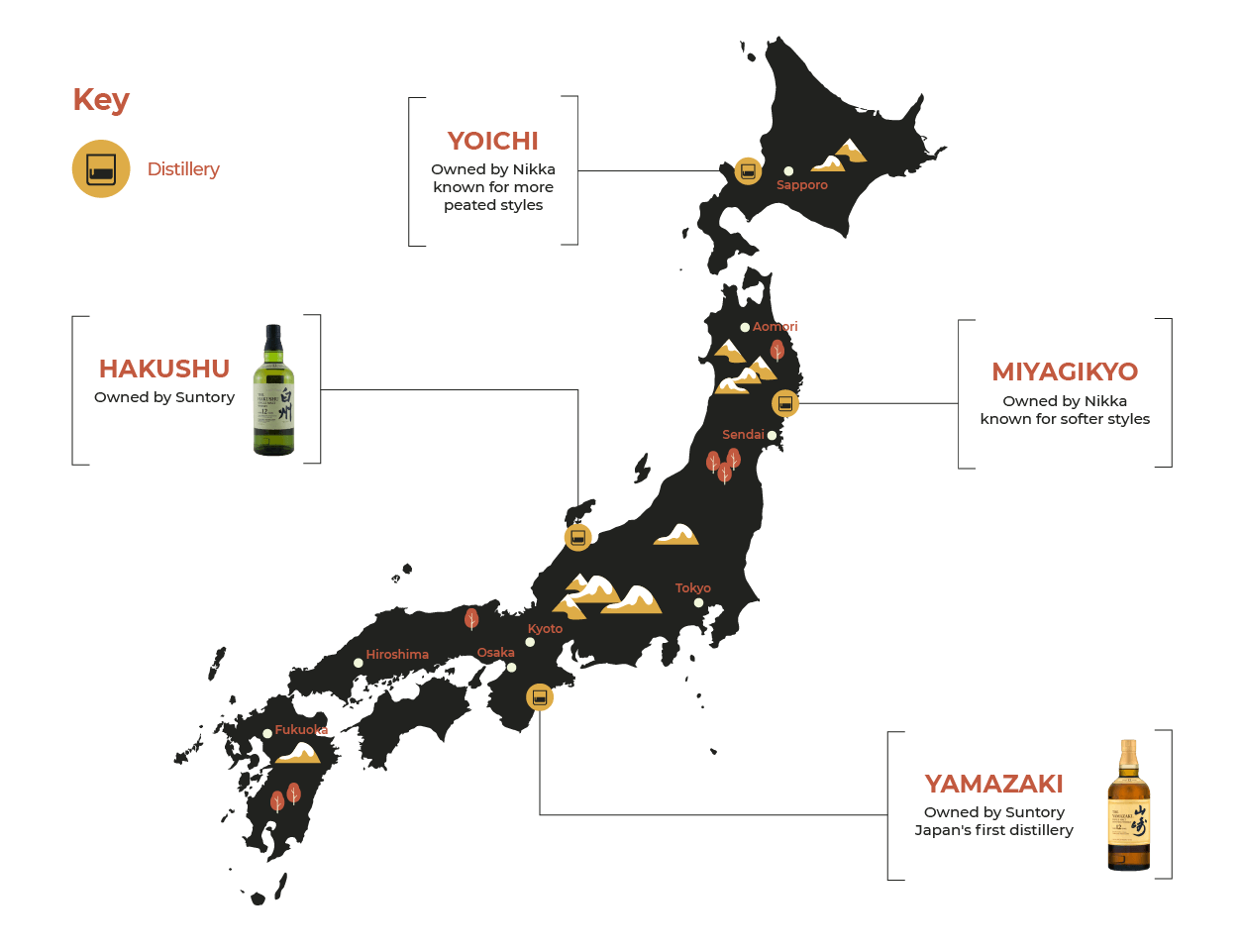Being able to trace its roots back to Scotland in the 1920s, bottles of Japanese whisky are now some of the most sought after whiskies in the world, even though Japan has less than a dozen distilleries producing the product.
Brands such as Nikka and Suntory dominate this group but there are a number of smaller companies producing some extraordinarily unique craft whiskies.
One of the key differences between Scotch and Japanese whisky is that whilst Scotch whisky blends are usually sourced from various distilleries around Scotland, in Japan, the individual distilleries produce all of the whiskies they use in the blending process themselves, meaning all of the whiskies used to make one blend come from just one distillery.
For more on this and the history of whisky in Japan, consider this article, or read this article exploring some of the latest developments in the Asian nation.
Because of this lack of sharing between distilleries, each distiller must innovate internally, making it difficult to pin down Japanese whisky to just one style.
That being said, Japanese whiskies tend to be lighter and more approachable than many of the heavily peated single malts from Scotland so as a general rule they are good for those just beginning their whisky journey.
Although the product is very similar in its distillation methodology to Scotch whisky, Japanese whisky gets its uniqueness from more than just the fact that distillers do not share stock with one another.
For more on this, consider this article, which helps to explain the differences further.
Another quality that is unique to Japanese whisky is that the distilleries sometimes use casks that have previously been used in the production of the Japanese spirit umeshu, a type of liqueur made from ume fruit steeped in alcohol and sugar.
This type of ageing results in a whisky that is sweeter in taste and more velvety in texture than those aged in traditional charred oak, rum, or sherry casks.
Another style of ageing that is found traditionally in Japanese whiskies is the mizunara cask ageing process.
Mizunara, a type of oak tree native to Japan, is higher in moisture and more porous, making it far more difficult to craft into barrels than other types of oak grown elsewhere and this makes it very expensive to purchase and use.
Taste wise, the use of mizunara oak in the ageing process imparts flavours of sandalwood, incense, coconut, and other spices to the flavour profile of the resulting whisky.
As mentioned previously, brands such as Suntory and Nikka dominate the Japanese whisky market, however, there are a number of smaller distilleries making craft whiskies, called Ji-Whisky locally.
Besides these two large Japanese whisky houses, the significant distilleries to be aware of include White Oak Distillery and Mars Shinshu as well as a number of others that are not easily available except in Japan.
Japan's biggest whisky company, Suntory, owns three of the main distilleries on the island including Yamazaki, Hakushu, and Chita, and has been producing whisky since 1923.
The whiskies produced by Suntory are known for their typically lighter, more delicate flavours and texture that complements the refined tastes and traditions of the quintessential Japanese consumer.
The perfect expression of this lighter style can be found in the Suntory Kakubin Japanese Whisky, which is wonderfully light, sweet, and crisp in taste and texture, making it perfect for a whisky first-timer.
Japanese whisky company Nikka owns two distilleries, Yoichi and Miyagikyo, where they produce whiskies that are steeped in the traditional Scottish methods of making whisky.
This means they are renowned for being big and bold in flavour, perfectly showcased in their whisky Nikka From The Barrel, a blended Japanese whisky with characteristics of dried fruits and sweet spices.
When serving Japanese whisky make sure to follow the principles used in other whisky categories, which is to pour it neat, over ice, or with a splash of water, called mizuwari locally.
Other than the more traditional serving suggestions, Japan is famous for some more interesting local twists on how to enjoy their whisky, including oyuwari, serving whisky with hot water, and haiboru, the Japanese word for a highball or whisky and soda.
Because of the nuanced flavours present in Japanese whisky, it is important to be very careful when pairing various foods and dishes with your chosen bottle.
Smoky and peatier style Japanese whiskies, such as Hakushu 12 Year Old and Hakushu Heavily Peated, pair perfectly with smoked foods, including smoked salmon and smoky barbecue rib dishes.
Whiskies that are lighter in taste and texture, including Suntory Kakubin Japanese Whisky, tend to pair perfectly with softer cuts of white meat, sushi, and sashimi, as neither the dish nor the whisky overpowers the other.
There's a bottle of Japanese whisky out there for everyone. Here are some of the brands and bottles that we recommend you look out for the next time you're browsing whisky online or in-store.
You might be familiar with bourbon & Tennessee whiskey but do you know about the other types of whiskey coming out of America? Discover more in this deep dive guide.
All over the world, the craft revolution has taken control. In this deep dive guide, we shine some light on what’s happening in the world of craft vodka in Australia.
You’ve seen them on the shelves at bottle shops & bars but how much do you really know about tequila & it’s lesser-known relative mezcal? We uncover both of them in our in-depth guide.


